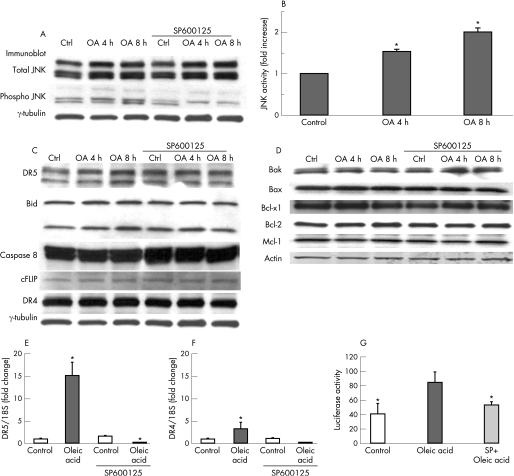Figure 4 Oleic acid (OA) treatment sensitises to TRAIL cytotoxicity via JNK dependent upregulation of DR5. Huh 7 cells were treated with 200 μM oleic acid, with and without a pharmacological JNK 1/2 inhibitor, SP600125. (A) JNK activation, evidenced by phosphospecific immunoblotting, is seen in oleic acid treated cells, and is prevented in the presence of SP600125. (B) JNK activity assay data in oleic acid treated Huh 7 cells are shown. JNK activity assay (described in methods) product, phospho‐c‐jun, was quantitated and normalised to total c‐jun expression for each experimental condition (p<0.001 compared to control). (C) Immunoblot analysis shows selective upregulation of DR5 in oleic acid treated cells, in a time dependent manner. The DR5 upregulation is abrogated in the presence of SP600125. DR4, Bid, caspase 8, and cFLIP levels are unchanged. (D) Immunoblot analysis for pro‐apoptotic and anti‐apoptotic members of the Bcl‐2 family demonstrates that expression of Bak, Bax, Bcl‐xl, Bcl‐2, and Mcl‐1 was unchanged. (E) Quantitative real time PCR was performed for DR5 expression in oleic acid treated Huh 7 cells, in the absence and presence of SP600125. Oleic acid treatment induced a 15‐fold increase in DR5 expression (p<0.05, compared to control); this was completely abrogated in the presence of SP600125 (p<0.05, compared to oleic acid alone). (F) Quantitative real time PCR was performed for DR4 expression in oleic acid treated Huh 7 cells, in the absence and presence of SP600125. A slight increase was observed in DR4 expression, this did not attain statistical significance (p = 0.2, compared to control). (G) Reporter gene assay using a DR5 luciferase plasmid demonstrates that 200 μM oleic acid treatment induced an increase in DR5 expression (p<0.05); this is JNK dependent as it is abrogated in the presence of SP 600125 (p<0.05).

An official website of the United States government
Here's how you know
Official websites use .gov
A
.gov website belongs to an official
government organization in the United States.
Secure .gov websites use HTTPS
A lock (
) or https:// means you've safely
connected to the .gov website. Share sensitive
information only on official, secure websites.
